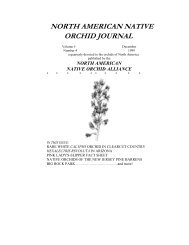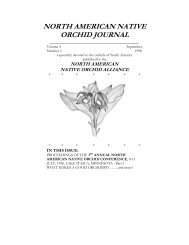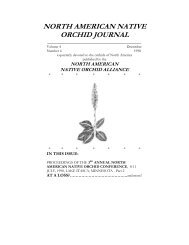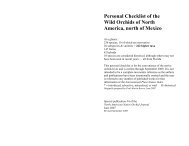north american native orchid journal - at The Culture Sheet
north american native orchid journal - at The Culture Sheet
north american native orchid journal - at The Culture Sheet
Create successful ePaper yourself
Turn your PDF publications into a flip-book with our unique Google optimized e-Paper software.
Brown & Folsom: WILD ORCHIDS OF THE WHITE MOUNTAINS OF NEW HAMPSHIRE AND MAINE<br />
Corallorhiza macul<strong>at</strong>a (Rafinesque) Rafinesque var. macul<strong>at</strong>a<br />
spotted coralroot<br />
forma flavida (Peck) Farwell–yellow-stemmed form<br />
forma rubra P.M. Brown–red-stemmed form<br />
Range: British Columbia east to Newfoundland, south to California,<br />
Arizona, and New Mexico; in the Appalachian Mountains south to<br />
<strong>north</strong>ern Georgia and South Carolina<br />
In the White Mountains region: occasional throughout, usually in<br />
open woodlands<br />
Plant: terrestrial, mycotrophic, 20-50 cm tall; stems bronzy-tan or, in the<br />
forma flavida, bright yellow, or in the forma rubra, red<br />
Leaves: none<br />
Flowers: 5-20; tepals typically brownish or, in the forma flavida, bright<br />
yellow or, in the forma rubra, red; lip white, spotted with madder purple;<br />
in the forma flavida, unspotted or, in the forma rubra, spotted with bright<br />
red; lip with the middle lobe not expanded, the sides obviously parallel;<br />
individual flowers 5.0-7.5 mm, the floral parts not wide-spreading and<br />
appearing somewh<strong>at</strong> cupped; individual flowers 5.0-7.5 mm, mentum obscure<br />
Habit<strong>at</strong>: rich mesic and mixed forests<br />
Flowering period: l<strong>at</strong>e May to July<br />
<strong>The</strong> spotted coralroot is the most frequently encountered species of coralroot<br />
found within eastern North America and is widespread and rel<strong>at</strong>ively common<br />
throughout much of the Northeastern. <strong>The</strong> vari<strong>at</strong>ion in the stem color is<br />
usually evident in even small popul<strong>at</strong>ions. Annual popul<strong>at</strong>ions vary gre<strong>at</strong>ly and<br />
often colonize disturbed areas.<br />
forma rubra<br />
209













